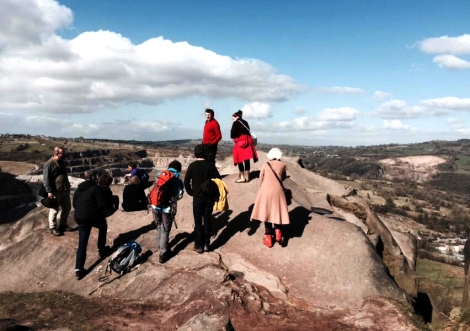Over the past week Future Works has drawn together people working in a number of fields to develop our understanding of the Derwent Valley region, and to consider questions of energy, community and co-production. Volunteers, employers and employees from Cromford Mill, Masson Mills, John Smedley, Strutt’s North Mill and Derby Silk Mill have welcomed us to their sites to think about energy past present and future… hoping to challenge perceptions, and share dilemmas and instances of agency.
Travelling together along towpaths, woodland edges and busy workshop floors, we heard how the relation between landscape and manufacture was transformed by innovations in our ability to make use of water, geology, wind and sun…and the pressure from factory owners to do things more quickly and in ways that required fewer skilled hands. The changes in our use of energy altered working relations and our connections with the landscape. At sites such as Cromford, the early development of sophisticated water management to power the factory required an understanding of the flows and seasonal changes in the river, along with skills to develop complex cogs and driver shaft systems and the ability to negotiate water use rights. These patterns, practices and understandings have been slowly forgotten with the advent of steam and later the connections to the grid… we wondered, will the desire to reinstate hydropower within the region, lead to them being reclaimed and developed in new ways?
When walking along Black Rocks, energetic story 1 team member Bradon Smith found a horseshoe fungus attached to a silver birch. This ‘tinder’ fungus used light fires had been found in the knapsack of the preserved Neolithic man found in the ice in the Alps… Just like the water management at Cromford this fungus requires certain knowledges and skills to afford its possibilities. Moving between these places along the valley it was made clear that all of the choices we make about energy are interdependent with the shifting landscape, our tools and know how, and the skills, desires, ways of working and cares we bring forth as communities. Changes in the way we use energy will also require a shift in all of these things…
I enjoyed seeing how each of us assembled personal reflections from those we met, things we overheard, traces in the landscape, designs, speculations, rumours and daydreams in order to began to get to grips with how we will be working together in the future, both as the Stories of Change team and as communities gathered around factories. As we walked along the river Folk Singer Lucy Ward spoke phrases aloud that struck a chord, upon arrival at the factory Bexie Bush soon made friends, and sitting in the kitchen upon our return to The Malthouse, landscape historian Nicola Whyte built imaginary (dry stone wall) architectures of questions that will challenge and provoke. Each of us involved is working to expand the field of our disciplines, yet coming together to pursue these lines of enquiry is still not easy, due not least to the effort each of us invests in what we do and the diversity of approaches within the team. Rachel Briscoe of Fanshen Theatre offered that a shared point of departure should be the ‘why?’ of a project…
Renata and I left the cottage where we were staying early each morning to interview people at each of the factory sites. In the gaps between each of these conversations new ideas sprung forth and connections could be made. What does it mean to assemble many different kinds of research, each with different methodologies, ethical imperatives, and ways of knowing? Can they meet to achieve shared goals? Our partners, (be they volunteers at Strutt’s Mill or the project managers at the site of the world’s first factory Derby Silk Mill) considered learning as central to any transformative process…For me, thinking about how we learn (from one another and the places that we share) is a lingering thought from what has been a fascinating week. I want to thank everyone who took part and were so generous with their time and energy; it feels like lots of new possibilities have begun to open up…


Sounds like you had a great week – looking forward to hearing more!
LikeLike